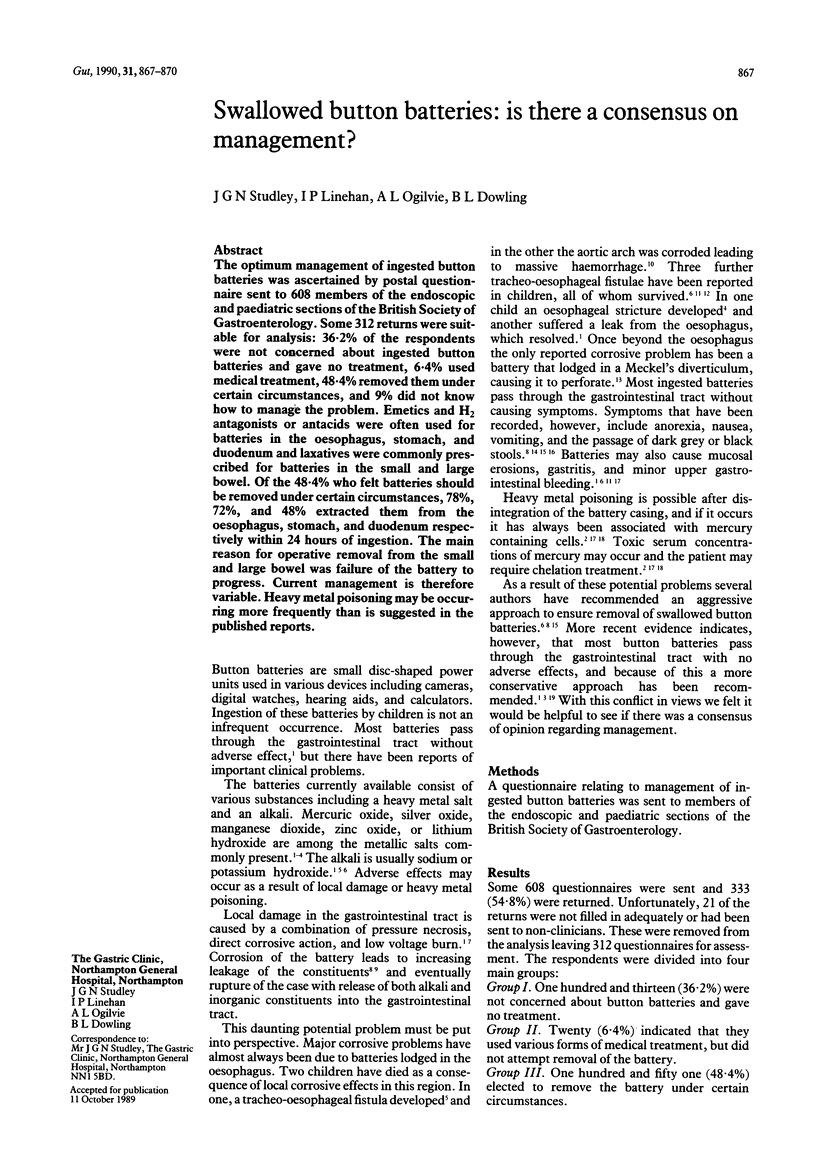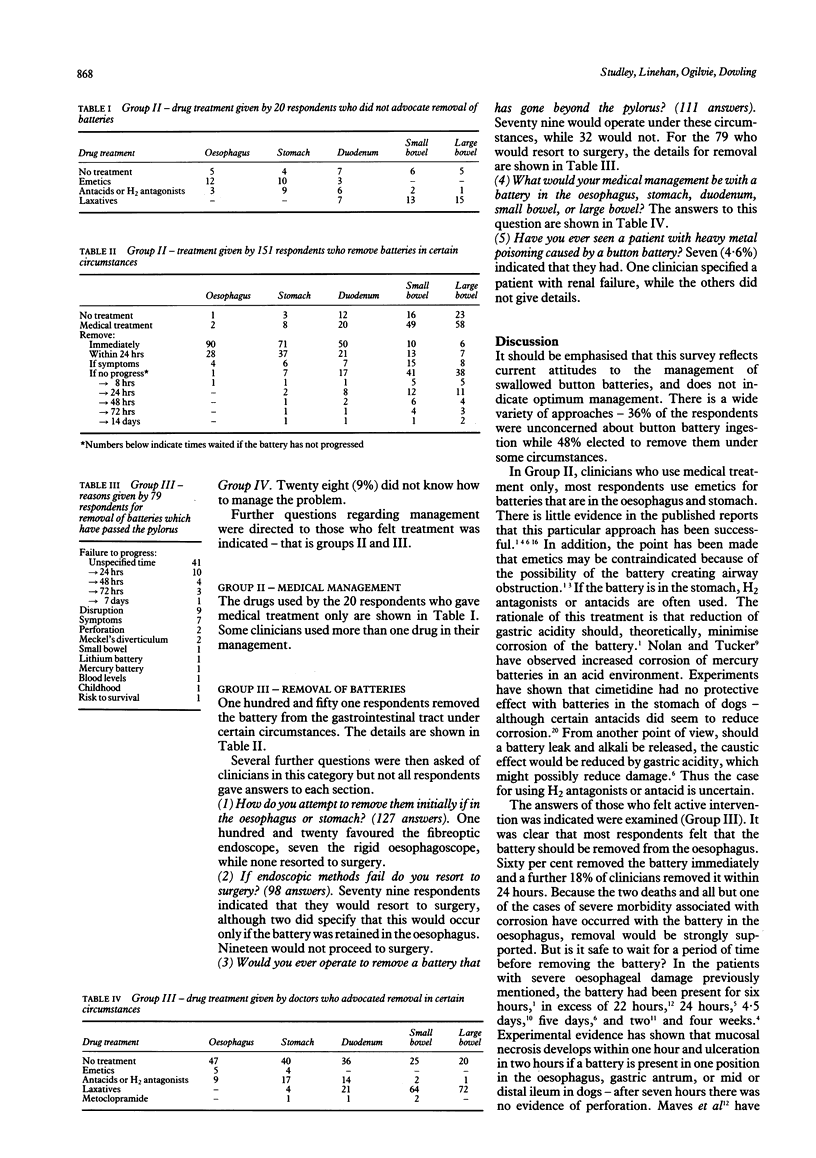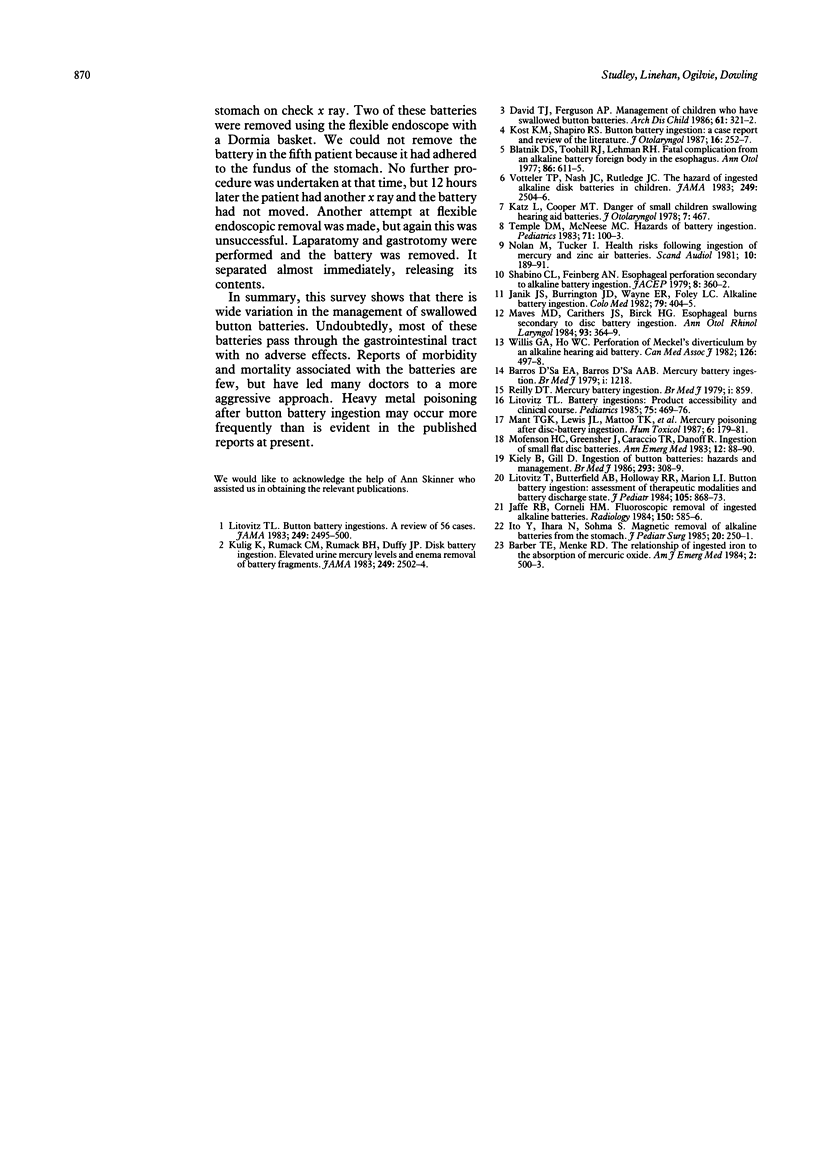Abstract
The optimum management of ingested button batteries was ascertained by postal questionnaire sent to 608 members of the endoscopic and paediatric sections of the British Society of Gastroenterology. Some 312 returns were suitable for analysis: 36.2% of the respondents were not concerned about ingested button batteries and gave no treatment, 6.4% used medical treatment, 48.4% removed them under certain circumstances, and 9% did not know how to manage the problem. Emetics and H2 antagonists or antacids were often used for batteries in the oesophagus, stomach, and duodenum and laxatives were commonly prescribed for batteries in the small and large bowel. Of the 48.4% who felt batteries should be removed under certain circumstances, 78%, 72%, and 48% extracted them from the oesophagus, stomach, and duodenum respectively within 24 hours of ingestion. The main reason for operative removal from the small and large bowel was failure of the battery to progress. Current management is therefore variable. Heavy metal poisoning may be occurring more frequently than is suggested in the published reports.
Full text
PDF



Selected References
These references are in PubMed. This may not be the complete list of references from this article.
- Barber T. E., Menke R. D. The relationship of ingested iron to the absorption of mercuric oxide. Am J Emerg Med. 1984 Nov;2(6):500–503. doi: 10.1016/0735-6757(84)90073-1. [DOI] [PubMed] [Google Scholar]
- Blatnik D. S., Toohill R. J., Lehman R. H. Fatal complication from an alkaline battery foreign body in the esophagus. Ann Otol Rhinol Laryngol. 1977 Sep-Oct;86(5 Pt 1):611–615. doi: 10.1177/000348947708600508. [DOI] [PubMed] [Google Scholar]
- D'Sa Barros E. A., D'Sa Barros A. A. Mercury battery ingestion. Br Med J. 1979 May 5;1(6172):1218–1218. doi: 10.1136/bmj.1.6172.1218-a. [DOI] [PMC free article] [PubMed] [Google Scholar]
- David T. J., Ferguson A. P. Management of children who have swallowed button batteries. Arch Dis Child. 1986 Apr;61(4):321–322. doi: 10.1136/adc.61.4.321. [DOI] [PMC free article] [PubMed] [Google Scholar]
- Ito Y., Ihara N., Sohma S. Magnetic removal of alkaline batteries from the stomach. J Pediatr Surg. 1985 Jun;20(3):250–251. doi: 10.1016/s0022-3468(85)80114-7. [DOI] [PubMed] [Google Scholar]
- Jaffe R. B., Corneli H. M. Fluoroscopic removal of ingested alkaline batteries. Radiology. 1984 Feb;150(2):585–586. doi: 10.1148/radiology.150.2.6691120. [DOI] [PubMed] [Google Scholar]
- Janik J. S., Burrington J. D., Wayne E. R., Foley L. C. Alkaline battery ingestion. Colo Med. 1982 Dec;79(12):404–405. [PubMed] [Google Scholar]
- Katz L., Cooper M. T. Re: danger of small children swallowing hearing aid batteries. J Otolaryngol. 1978 Oct;7(5):467–467. [PubMed] [Google Scholar]
- Kiely B., Gill D. Ingestion of button batteries: hazards and management. Br Med J (Clin Res Ed) 1986 Aug 2;293(6542):308–309. doi: 10.1136/bmj.293.6542.308-a. [DOI] [PMC free article] [PubMed] [Google Scholar]
- Kost K. M., Shapiro R. S. Button battery ingestion: a case report and review of the literature. J Otolaryngol. 1987 Aug;16(4):252–257. [PubMed] [Google Scholar]
- Kulig K., Rumack C. M., Rumack B. H., Duffy J. P. Disk battery ingestion. Elevated urine mercury levels and enema removal of battery fragments. JAMA. 1983 May 13;249(18):2502–2504. doi: 10.1001/jama.249.18.2502. [DOI] [PubMed] [Google Scholar]
- Litovitz T. L. Battery ingestions: product accessibility and clinical course. Pediatrics. 1985 Mar;75(3):469–476. [PubMed] [Google Scholar]
- Litovitz T. L. Button battery ingestions. A review of 56 cases. JAMA. 1983 May 13;249(18):2495–2500. [PubMed] [Google Scholar]
- Litovitz T., Butterfield A. B., Holloway R. R., Marion L. I. Button battery ingestion: assessment of therapeutic modalities and battery discharge state. J Pediatr. 1984 Dec;105(6):868–873. doi: 10.1016/s0022-3476(84)80068-2. [DOI] [PubMed] [Google Scholar]
- Mant T. G., Lewis J. L., Mattoo T. K., Rigden S. P., Volans G. N., House I. M., Wakefield A. J., Cole R. S. Mercury poisoning after disc-battery ingestion. Hum Toxicol. 1987 Mar;6(2):179–181. doi: 10.1177/096032718700600212. [DOI] [PubMed] [Google Scholar]
- Maves M. D., Carithers J. S., Birck H. G. Esophageal burns secondary to disc battery ingestion. Ann Otol Rhinol Laryngol. 1984 Jul-Aug;93(4 Pt 1):364–369. doi: 10.1177/000348948409300416. [DOI] [PubMed] [Google Scholar]
- Mofenson H. C., Greensher J., Caraccio T. R., Danoff R. Ingestion of small flat disc batteries. Ann Emerg Med. 1983 Feb;12(2):88–90. doi: 10.1016/s0196-0644(83)80379-5. [DOI] [PubMed] [Google Scholar]
- Nolan M., Tucker I. Health risks following ingestion of mercury and zinc air batteries. Scand Audiol. 1981;10(3):189–191. doi: 10.3109/01050398109076179. [DOI] [PubMed] [Google Scholar]
- Reilly D. T. Mercury battery ingestion. Br Med J. 1979 Mar 31;1(6167):859–859. doi: 10.1136/bmj.1.6167.859. [DOI] [PMC free article] [PubMed] [Google Scholar]
- Shabino C. L., Feinberg A. N. Esophageal perforation secondary to alkaline battery ingestion. JACEP. 1979 Sep;8(9):360–363. doi: 10.1016/s0361-1124(79)80259-2. [DOI] [PubMed] [Google Scholar]
- Temple D. M., McNeese M. C. Hazards of battery ingestion. Pediatrics. 1983 Jan;71(1):100–103. [PubMed] [Google Scholar]
- Votteler T. P., Nash J. C., Rutledge J. C. The hazard of ingested alkaline disk batteries in children. JAMA. 1983 May 13;249(18):2504–2506. [PubMed] [Google Scholar]
- Willis G. A., Ho W. C. Perforation of Meckel's diverticulum by an alkaline hearing aid battery. Can Med Assoc J. 1982 Mar 1;126(5):497–498. [PMC free article] [PubMed] [Google Scholar]


